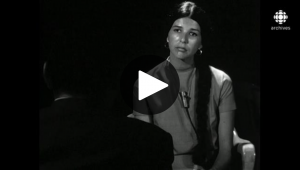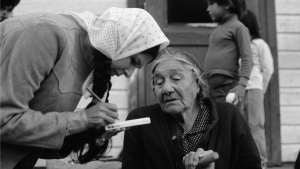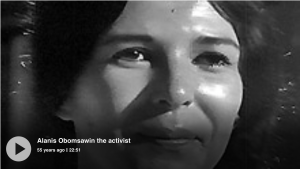Alanis Obomsawin
“So much history can be lost if no one tells the story — so that’s what I do. I tell the stories. This is my way of fighting for social change.”
-Alanis Obomsawin
Alanis Obomsawin is one of Canada’s most distinguished documentary filmmakers. She is a pioneer in indigenous filmmaking and has made over 50 films so far in her career. Born 31 August 1932 near Lebanon, New Hampshire, she comes from the Abenaki Nation and began her career as a professional singer and storyteller before joining the National Film Board (NFB) in 1967. Her award-winning films address the struggles of Indigenous peoples in Canada from their perspective, giving prominence to voices that have long been ignored or dismissed. A Companion of the Order of Canada and a Grand Officer of the Ordre National du Québec, she has received the Prix Albert-Tessier and the Canadian Screen Awards’ Humanitarian Award, as well as multiple Governor General’s Awards, lifetime achievement awards and honorary degrees. In 2019, the Vancouver Biennale awarded her its Artist of Distinction Award.
Why did Alanis Obomsawin begin to make films?
She didn’t set out at first to become a filmmaker—what she wanted was to create change.
In 1966, she was a singer-songwriter and storyteller, and was profiled on the CBC program Telescope for her local activism and “near superhuman” efforts to fund — through donations, concerts and lectures — a swimming pool for her community on the Odanak reserve after the local river was deemed too polluted and when indigenous children were forbidden from using a nearby pool in a white community. She wanted to bring change on this issue, so that indigenous children may have access to swimming pools like white children. After noticing her in the CBC Telescope feature in 1966, Wolf Koenig and Bob Verrall, producers at the National Film Board (NFB), hired Obomsawin as a consultant on projects that related to First Nations peoples. In 1971, she directed her first film, Christmas at Moose Factory, and in 1977 she became a permanent staff member at the NFB. Since then, she’s made over 50 films and counting.
To look at her body of work is to see a representation of a tremendous period of change for Indigenous people and nations in Canada. This cannot be overstated. The impact of her films on Canadian film making and recognition of indigenous voices and perspectives in this country has been felt across the country over her long career. “I think her whole career is an act of decolonization,” explained Jesse Wente, director of the Indigenous Screen Office. “An act of decolonization of our screens, of our institutions … but most importantly a decolonization of our thoughts, and how we think and see the world.”
Committed to redressing the invisibility of Indigenous peoples, Alanis Obomsawin’s filmmaking style resides in the unique ability to pair Indigenous oral traditions with methods of documentary cinema. “As a child,” she says, “I wondered ‘What can I do?’ The children need to hear another story than what the school books told. Stories about savages, scalping, the Devil’s language… I’m going to tell a different story with children.”
Media Resources/Interviews:
When she travels, Alanis Obomsawin actively makes a point to visit schools, and speak to students across Canada. Her interviews offer valuable insights and context for her films. These short interviews and articles below offer glimpses into her filmmaking process and how she has seen Canada change over the last 50 years. Teachers are encouraged to use these resources in the classroom alongside their chosen films so that students may learn about Alanis Obomsawin the person, through her own words.
Where the Sun Rises: The Films of Alanis Obomsawin. Jason Ryle, National Film Board of Canada 2019.
A very useful short article on her films, her approaches to film making, and the impact her work has had in this country.
 Legacy interview, Governor General’s Performing Arts Awards, 2015.
Legacy interview, Governor General’s Performing Arts Awards, 2015.
5:56 min.
Alanis Obomsawin, 2008 GGPAA laureate, talks about her career and receiving a GGPAA in an interview on May 29, 2015. She explains her strategy for interviewing compassionately, why she uses sound before interviewing on camera, and why she doesn’t make films for the audience.
 TVO Doc Studio: Alanis Obomsawin, 2015.
TVO Doc Studio: Alanis Obomsawin, 2015.
7:32 min
Documentary Filmmaker Alanis Obomsawin talks about her career and what inspired her to make films on Aboriginal issues. How does she work with her crews, how does she work with communities?
22:51 min.
Filmed in the 60s, some of the language in this CBC clip is outdated. If using this clip in the classroom, invite students to notice and discuss the kind of language or biases they see in the interview. How does the reporter talk about Alanis, her community, and culture?
 Radio-Canada interview on July 22, 1964.
Radio-Canada interview on July 22, 1964.
7.58 min in French
This French interview was filmed in the 60s, some of the language and line of questioning now seems outdated. If using this clip in the classroom, ask students to notice the kind of language or biases they see in the interview. How does the reporter talk about Alanis, her community, and culture? How does Alanis respond?
To watch a selection of Alanis Obomsawin’s films, CLICK HERE


